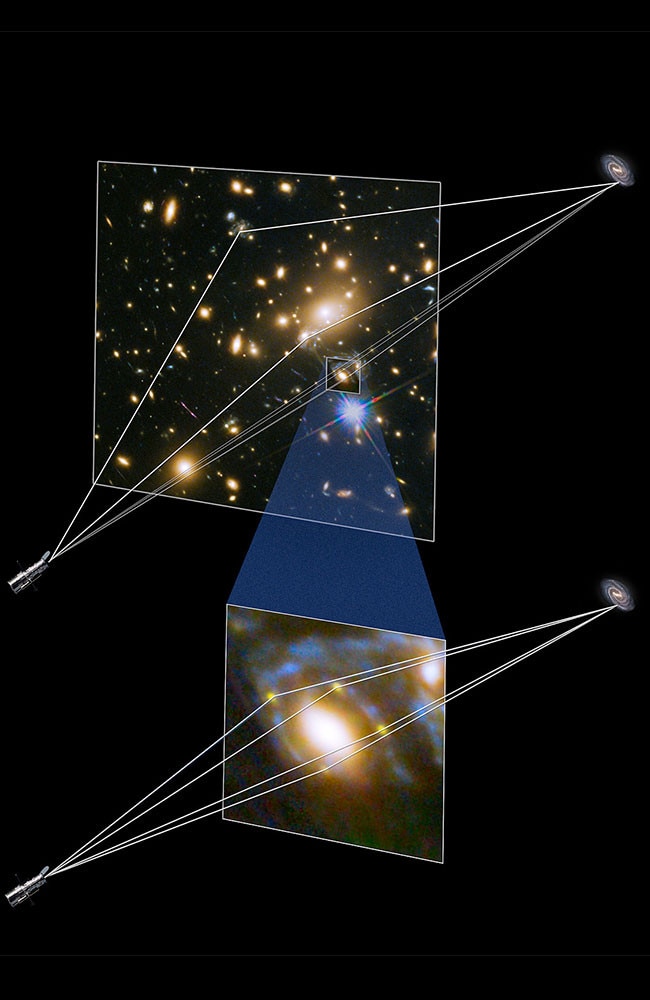Hubble finds a four-cornered view of an ancient dying star
BOOM. Bend. Repeat. The universe doesn’t only have a sense of humour, it’s also a tease. Twists in space and time have given us a four-split view of a supernova. And we’ll get a re-run.
BOOM. Bend. Repeat. This is one of the universe’s greatest explosions. But throw in a cluster of galaxies and a mysterious force, and you get a warp in space and time that has astronomers on the edge of their seats.
NASA’s Hubble Space Telescope has been focusing on the interstellar phenomenon of “gravitational lensing” in recent times. Among the most striking light-bending images to emerge recently was a “smiley face”.
But the universe doesn’t only have a sense of humour. It’s also a tease.
We’ve caught four views of an interstellar repeat.

INTERGALACTIC PINBALL
The Hubble telescope, now approaching it’s 25th birthday, has given astronomers an unusual four-dimensional view of an ancient dying star.
The supernova was, by chance, directly behind a dense cluster of huge galaxies designated MACS J1149+2223.
The cluster is more than 5 billion light years away. But the combined gravitational influence of these galaxies has had an influence on the even older light of a supernova behind them.
This light is being buckled, warped and focused as it passes through an intergalactic gravitational maze.
Such a sight has been expected. It has even been named: An “Einstein Cross”.
It’s a four-cornered arrangement of views of a single event.
Astronomers anticipate an unusual side effect: As a result of the twists and turns of space-time, we may eventually get to watch a re-run of the star’s death.

UNIVERSAL RERUN
“When the four supernova images fade away as the explosion dies down, astronomers will have a rare chance to catch a rerun of the explosion,” a statement released by the Hubble research team reads.
“The supernova images do not arrive at the Earth at the same time because, for each image produced, the light takes a different route. Each route has a different layout of matter — both dark and visible — along its path. This causes bends in the road, and so for some routes the light takes longer to reach us than for others.”
But within the bent light is more than a spectacular view with the promise of a repeat. There’s evidence of the very nature of space and time itself.
Several research teams, including the Australian National University and the University of Melbourne, are now analysing the image.
“It’s perfectly set up, you couldn’t have designed a better experiment,” ANU Research School of Astronomy and Astrophysics researcher Dr Brad Tucker said.
“You can test some of the biggest questions about Einstein’s theory of relativity all at once — it kills three birds with one stone.”

CASTING LIGHT ON DARK MATTER
The four-pronged distortion of the supernova’s light allows scientists to calculate the strength of gravity in the intervening galaxy cluster, which can be used to calculate the mass of “dark matter” present. It’s a mysterious and invisible substance which glues the universe together. We know it exists only because it produces gravity.
The leasing effect also creates a natural “time machine”, projecting an ancient supernova from an era much earlier than astronomers are usually capable of seeing.
“It’s a relic of a simpler time, when the universe was still slowing down and dark energy was not doing crazy stuff,” Dr Tucker said.
“We can use that to work out how dark matter and dark energy have messed up the universe.”

WHERE’S THE REMOTE?
But the spectacular light show is already old news.
If we had looked, we’d have seen it before.
“We think the supernova may have appeared in a single image some 20 years ago elsewhere in the cluster field,” Frontier Fields Supernova team leader Steve Rodney says.
“And, even more excitingly, it is expected to reappear once more in the next one to five years — and at that time we hope to catch it in action.”




